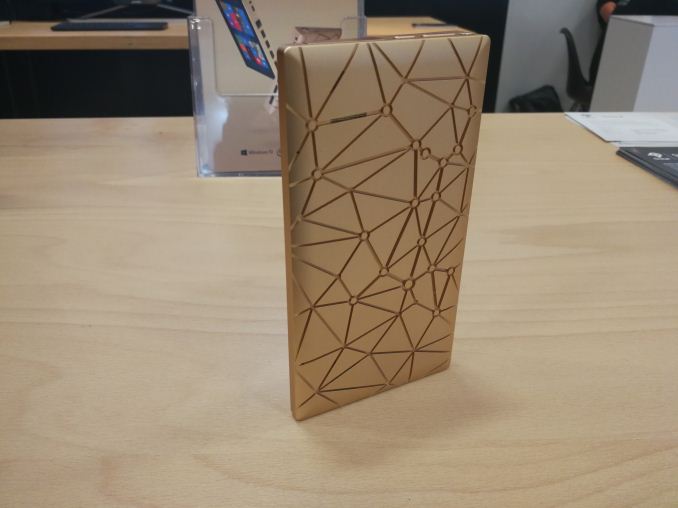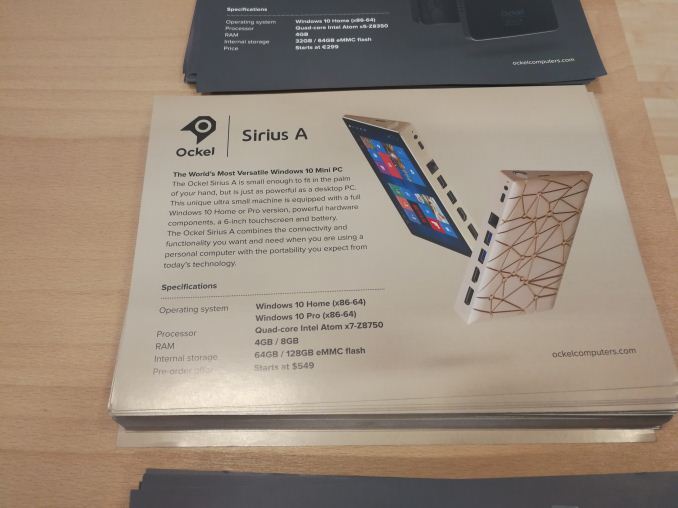Ockel Sirius A is Nearing Primetime: Smartphone-Sized PC with 6-inch 1080p Display
by Ian Cutress on September 4, 2017 1:00 PM EST
Last year, at IFA 2016, I stumbled across the Ockel Sirius project. In its infancy, the device was seemingly straight forward: put a full PC into a smartphone sized chassis. At the time the project was in its early stages, and in my hands was a non-functioning mockup before the idea went to crowd funding. Normally we do not cover crowdfunding projects as a general rule, so I did not write it up at the time. But I did meet the CEO and the Product Manager, and gave a lot of feedback. I somehow bumped into them again this year while randomly walking through the halls, and they showed a working version two months from a full launch. Some of those ideas were implemented, and it looks like an interesting mash of smartphone and PC.
The Sirius A is easily as tall as, if not slightly taller than, my 6-inch smartphones, the Mate 9 and LG V30, and the requirements for PC ports means that it is also wider, particularly on one side which has two USB 3.0 ports, a HDMI 1.4 port, a DisplayPort, Gigabit Ethernet (alongside internal WiFi) and two different ways to charge, via USB Type-C or with the bundled wall adaptor. The new model was a bit heavier than the prototype from last year, namely because this one had a battery inside – an 11Wh / 3500 mAh battery, good for 3-4 hours of video consumption I was told. The weight of the prototype was around 0.73 lbs, or just over 330 grams. This is 2-2.5x a smartphone, but given that I carry two smartphones anyway, it wasn’t so much of a big jump (from my perspective).
Perhaps the reason for such a battery life number comes from the chipset: Ockel is using Intel’s Cherry Trail Atom platform here, in the Atom x7-Z8750. This is a quad-core 1.60-2.60 GHz processor, with a rated TDP of 2W. It uses Intel’s Gen8 graphics, which has native H.264 decode but only hybrid HEVC and VP9, which is likely to draw extra power. The reason for Cherry Trail is one of time and available parts – Intel has not launched a 2W equivalent processor with its new Atom cores, and also Ockel has been designing the system for over a year, meaning that parts would have had to have been locked down. That aside, they see the device more as a tool for professionals that need a full windows device but do not want to carry a laptop. With Windows 10 in play, Ockel says, the separate PC and tablet modes take care of a number of pain points with Windows touch screen interactions.
Implemented since the last discussion with them was a fingerprint sensor, for an easy unlock. Ockel are using a Goodix sensor, similar to the Huawei Matebook X and Huawei smartphones. This feature I requested just for easy access to the OS after picking the device up, rather than continually inserting a password. The power button in this case merely turns off the display, rather than putting the device into a sleep/hibernate state.
The hardware also supports dual display output, from both the HDMI and DisplayPort simultaneously, with the idea that a user can plug the device into desktop hardware when at a desk.
Ockel is set to offer two versions of the Sirius: the Sirius A and the Sirius A Pro. Both systems will have the same SoC, the same 1920x1080 IPS panel, and the same ports, differing in OS version (Win 10 Home vs Win 10 Pro), memory (4GB vs 8GB LPDDR3-1600) and storage (64GB vs 128GB eMMC). There is an additional micro-SD slot, and Ockel will be offering both versions of the device with optional 128GB micro-SD cards.
| Ockel Sirius | ||
| Sirius A | Sirius A Pro | |
| CPU | Intel Atom X7-Z8700, 4C/4T, 1.6 GHz Base, 2.56 GHz Turbo 14nm, Airmont Cores |
|
| GPU | Intel HD Graphics 405, 12 EUs 200 MHz Base, 600 MHz Turbo |
|
| DRAM | 4GB LPDDR3-1600 | 8GB LPDDR3-1600 |
| Storage | 64GB Samsung eMMC 5.0 + microSD |
128GB Samsung eMMC 5.0 + microSD |
| Display | 6.0-inch 1920x1080 IPS Glossy Multi-Touch |
|
| OS | Windows 10 Home | Windows 10 Pro |
| USB | 2 x USB 3.0 1 x USB Type-C |
|
| Networking | 1 x Realtek RJ-45 1 x 802.11ac Intel AC3165 Bluetooth 4.2 |
|
| Display Outputs | 1 x HDMI 1.4a 1 x DisplayPort |
|
| Audio | Realtek Audio Codec Two Rear Speakers Embedded Microphone 3.5mm Jack |
|
| Sensors | Fingerprint (Goodix) Accelerometer Gyroscope Magnetometer |
|
| Camera | Front Facing, 5MP | |
| Battery | Li-Po 3000 mAh (11Wh) | |
| Dimensions | 85.5 x 160.0 x 8.6 to 21.4 mm 3.4 x 6.3 x 0.3 to 0.8 inches 334g / 0.736 lb |
|
| Price | Pre-Order: $549 Retail: $699 |
Pre-Order: $649 Retail: $799 |
Pricing will start at $699 for the base Sirius A model (W10 Home, 4GB, 64GB), $799 for the Sirius A Pro model (W10 Pro, 8GB, 128GB), and an additional $50 for the microSD card but $150 cheaper with a pre-order via Ockel's website. This will come across as a lot, for what is an Atom-based Windows 10 PC in such a small form factor, when similar full-sized laptops can be had for $300-$400, depending on specifications, such as the HP Stream or Chuwi Lapbook which are strong contenders. Ultimately Ockel is going after a crowd that wants a smartphone-like sized mobile PC with a mobile like experience. There will be barriers to this, such as the lack of a direct dialling app (could use Skype), no rear facing camera, and potential battery life.
Pre-order sales are still available through Ockel's website, with mass production to start in October and shipments from November 20th. Buying it with a pre-order also provides a set of wireless earbuds. We’ve been offered a review sample – I’m unsure at this point if we should get Ganesh to review it as a mini-PC, Brett to review it as a laptop, or someone else to review it as a smartphone.
















65 Comments
View All Comments
Notmyusualid - Thursday, September 7, 2017 - link
Any airline that bans laptops - will crash.And I don't mean out of the sky - I mean financially.
Right after September 11th, some airlines banned them, us business users just caught other carriers - it didn't take long for them to readjust.
Mugur - Tuesday, September 5, 2017 - link
GPD Pocket looks way better than this. And cheaper. And with a real keyboard. And with double the battery.phoenix_rizzen - Friday, September 8, 2017 - link
The missing piece is the keyboard. There's probably enough volume in a squared off design to add a slide-out keyboard, with extra battery to boot. You really can't call this thing a "pocket PC" without a keyboard. It's just another generic Windows 10 tablet.IGTrading - Tuesday, September 5, 2017 - link
We would purchase this for the whole office and I'd personally get 2 more for our home, but only if powered by AMD's Mullins or a 14nm version of that.There is no point in using Intel's low performance Atom CPUs with even lower performing GPUs.
It is like spending serious money on failed, outdated, low end technology.
Tams80 - Tuesday, September 5, 2017 - link
It is time to move on from Intel Atom, as Intel obviously don't give two hoots about it.Unfortunately there aren't any real alternatives for x86 devices to use. Unless AMD get their act together and release a very low power APU, it's all we're going to have.
serendip - Tuesday, September 5, 2017 - link
Intel killed its 2-4 W Apollo Lake parts so the old, outdated Cherry Trail is all there is for x86 on tablets. I doubt AMD could have 2W Zen parts any time soon.edzieba - Tuesday, September 5, 2017 - link
Looks like the GPD Pocket is the nearest competitor, with the main difference being the GPD Pocket is more like a super-shrunken laptop, while the Ockel Sirius looks more like a NUC that happens to have a touchscreen and battery.speculatrix - Sunday, September 10, 2017 - link
The GPD doesn't have a memory card slot or webcam, which could stop some from buying itBrokenCrayons - Tuesday, September 5, 2017 - link
It's an interesting device, but part of the reason why it's similar in size when compared to a smartphone is because phones have turned huge in recent times with inflation of screen size. Anyway, I can see useful applications for a device like this, but many of those capabilities can already be found on a phone I'm already carrying around with me so the advantages aren't huge. I'd be forced to compare it directly to my existing mobile device to determine if there's any value having Windows in such a small system or if the things Windows can do for me aren't worth the extra thing I'd have to take with me.serendip - Tuesday, September 5, 2017 - link
I've got a cheap $200 Teclast tablet that runs Windows 10 on a similar Cherry Trail Atom chip. I get 8-9 hours on a 10" iPad-spec screen so it's good enough for a day at work. I don't think I could get anything done on a 6" screen with Windows, I had an older 8" tablet that was almost impossible to use even with display scaling turned up.$500-600 is way too much when cheaper and more capable alternatives are available. This thing sounds more like a NUC with a screen tacked on rather than a complete Windows tablet.